


Antimatter at the
University of Bologna
| The Physics Department of the University of Bologna is
situated in two buildings, the "historic" building in Via Irnerio (see photograph
in fig. 1) and the new building in Viale Berti Pichat. |
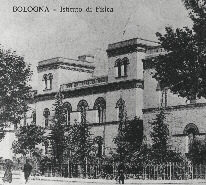
Fig. 1: The "historic building" of the Physics Department of the University
of Bologna.
(Credit: University of Bologna) |
Physicists from the
Department of Physics and the Bologna Section of
INFN (National Nuclear Physics Institute) have been conducting
research into antimatter for about 40 years.
-
1965: Ten years after the discovery of the antiproton, a group lead
by Prof. Antonino Zichichi, using the PS
(Proton Synchroton)
accelerator
 of CERN
in Geneva, observed for the first time the
antideuteron, made of an antiproton and an antineutron. This observation
happened at the same time as the one made by American colleagues at the
AGS
(Alternating Gradient Synchroton) accelerator of the
Brookhaven
National Laboratory, near New York. of CERN
in Geneva, observed for the first time the
antideuteron, made of an antiproton and an antineutron. This observation
happened at the same time as the one made by American colleagues at the
AGS
(Alternating Gradient Synchroton) accelerator of the
Brookhaven
National Laboratory, near New York.
- 1978 : Thirteen years later a group lead by Prof. Giorgio Giacomelli,
in cooperation with French colleagues, detected
more complex antinuclei at the CERN
SPS (Super Proton Synchroton): antitritium and antihelium-3, made by an
antiproton and two antineutrons and by two antirprotons and one antineutron,
respectively. Similar observations were made by Russian groups at the Serpukhov
accelerator in Russia.
At the end of the sixties
Bruno
Touschek proposed colliding positrons with electrons to study the
annihilation features. This led to the construction of the first
positron-electron
collider AdA at
the Laboratori Nazionali di Frascati; it was later followed by a much larger collider ,
ADONE. ,
ADONE.

Fig. 2: BCF detector at ADONE.
(Credit: INFN)
|
- 1969-1974:
A group of Bologna physicists was one of the first groups to
perform experiments at the Frascati ADONE
collider (BCF experiment).
|
The advantages offered by positron-electron colliders led to the
construction of newer and more powerful colliders in the US, USSR and in Europe.
The last positron-electron collider was the
LEP
(Large Electron Positron collider) at CERN, which operated from 1989 to 2000;
with its 27 km circumference, it was the largest accelerator ever built.
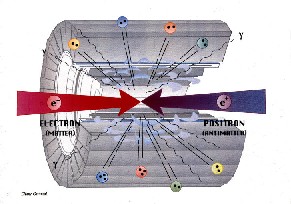
Fig. 3:
Representation of a positron-electron collision at high energies provided by LEP.
(Credit: CERN
photo-di/9105064)
|
- 1989 - 2000: Three groups
from Bologna participated in the experiments
DELPHI,
L3 and OPAL at LEP,
taking precision
measurements of all the parameters of the
Standard Model of Particle Physics; they established the existence of just three types of light neutrinos.
|
Parallel to the
developments in positron-electron colliders there were
also developments in proton-proton and antiproton-proton colliders.
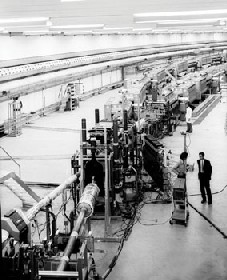
Fig.
4: One of the
intersecting regions of the ISR collider at CERN
(Credit:
CERN
Courier (April 2002))
|
- 1981 - 1983: At the
Intersection Storage Rings (ISR) at CERN one group of researchers from
Bologna, in cooperation with US and European groups, studied antiproton-proton
collisions and compared their main features with those of proton-proton
collisions.
|
The possibility of performing proton-antiproton collisions at higher energy
using the existing CERN
SPS
accelerator as a collider was demonstrated in the early '80s; the collider led
to the discovery of the W+, W¯, Z0 particles, which are
the mediators of the
weak interactions. Carlo Rubbia and Simon Van der Meers won the Nobel prize for this discovery.
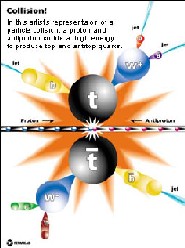
Fig. 5:
Representation of the production of the quark top in high energy
proton-antiproton collisions.
(Credit:
Fermilab)
|
- 1988 - 2002: The highest energy proton-antiproton
collider is at
Fermilab, near Chicago.
One group from Bologna measured the total cross section (the probability of
collision) for proton-antiproton collisions and discovered that it increases
with an increase in energy.
Another group from Bologna is part of the large CDF collaboration; this detector (Collider Detector Facility)
was used to discover the
sixth quark, the top
quark, the elementary particle with the highest mass (mt ~ 175 GeV).
|
Low energy matter-antimatter collisions have also been performed.
- 1990 - 1996: A group of physicists
from the University of Bologna took part in the OBELIX at the Low
Energy Antiproton Ring (
LEAR
 ) at CERN. The experiment could detect all
particles, neutral and charged, produced in nucleon antinucleon collisions at
rest or at low energy. ) at CERN. The experiment could detect all
particles, neutral and charged, produced in nucleon antinucleon collisions at
rest or at low energy.
|
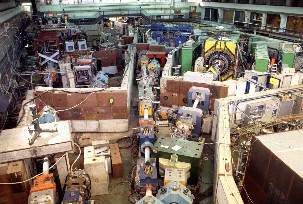
Fig. 6: LEAR. Overview of the experimental area.
(Credit: CERN
Bulletin 47/98 - 16 November 1998)
|
- Future : In 2005 the AMS
experiment will be installed in the International Space Station for a three
year mission. A test was performed using a preliminary version of the detector
in the Space Shuttle during 1998. The main purpose of the experiment is the
search for antihelium anti nuclei (and also anticarbon) which could indicate
the existence of a region of the universe populated with antistars. The
experiment involves a large international group of collaborators, who are now building and testing the experimental apparatus.
|
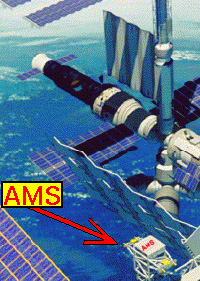
Fig 7: The International Space Station, with the indication of the position where
AMS will be installed.
(Credit: AMS
experiment)
|
The Webweavers: Last modified 01/15/2013 13:51:32
|

